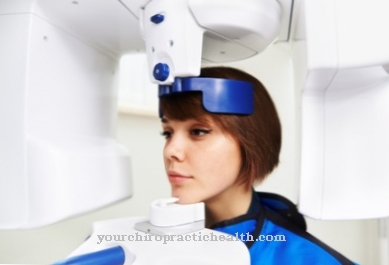A Ophthalmoscopy or Ophthalmoscopy is a routine examination at the ophthalmologist. It is used not only for eye diseases, but also for diseases that are dangerous to the eyes, such as diabetes. This examination checks whether the eye shows any abnormal changes.
What is an ophthalmoscope?
.jpg)
The Ophthalmoscopy is a painless and harmless examination of the fundus. The eye is illuminated and the ophthalmologist looks into the inside of the eye through the pupil with the help of a magnifying glass.
This is used to examine parts of the eye that are otherwise not visible, such as the retina, choroid, papilla and blood vessels, for pathological changes. An ophthalmoscope is used both for acute eye complaints such as injuries to the eye and for long-term diseases that affect the eyes, such as diabetes.
Function, effect & goals
As part of an annual preventive check-up, a regular Ophthalmoscopy identify the first signs of a possible illness early to avoid more serious damage to the eye. Because eye diseases can develop without any symptoms being felt.
An ophthalmoscope is therefore used to identify possible diseases or changes in the eye so that they can be treated in good time. The ophthalmoscope is also used to examine various diseases. With some diseases such as diabetes, high blood pressure or vascular calcification, it is very important to check the fundus and blood vessels regularly because these diseases can damage the eyes.
An ophthalmoscope is also used when there is a potential for retinal detachment or if the optic nerve may be damaged. With the help of the ophthalmoscope, e.g. Vascular occlusions in central veins or arteries, glaucoma or tumors inside the eye.
An age-related change in the retina (macular degeneration), which occurs more frequently after the age of 50 and can lead to blindness, is recognized early by regular ophthalmoscopy and can often be treated in good time.
Above all, the ophthalmoscope allows an examination of the retina (retina), choroid (choroid) and the blood vessels supplying them. The optic nerve head (papilla), from which the optic nerve migrates into the eye socket, can also be examined. The ophthalmoscope is performed by illuminating the pupil with the help of a lamp, whereby the pupils can also be enlarged using special eye drops for a better overview.
A distinction is made between direct and indirect ophthalmoscopy. In direct ophthalmoscopy, an electric eye mirror (ophthalmoscope) is used, which is equipped with a magnifying glass, various lenses and a lamp. This ophthalmoscope is brought as close as possible to the eye by the doctor in order to then shine through the pupil into the inside of the eye. The different lenses enable ametropia to be compensated for, either by the doctor or by the patient.
With the direct ophthalmoscope, only a small part of the fundus is visible, but it is greatly enlarged and upright. During this examination, the patient looks at a distant object. With the direct ophthalmoscope it is possible to precisely check details such as the tendon exit point and the yellow spot (macula). A detailed examination of the central blood vessels is also carried out here.
The indirect ophthalmoscope requires an additional light source. A converging lens is used here, which the doctor holds at a certain distance in front of the patient's eye, supporting himself with his hand on the patient's forehead. At the same time, with the other hand, he directs the light source onto the eye. Indirect ophthalmoscopy allows a better overall view, but a lower magnification than direct ophthalmoscopy.
You can find your medication here
➔ Medicines for visual disturbances and eye complaintsRisks & dangers
The Ophthalmoscopy is a routine examination at the ophthalmologist. Usually it is harmless and not associated with risks.
Before an ophthalmoscope, the doctor determines whether there is anything that speaks against the use of medication to dilate pupils. For example, these drugs can trigger a glaucoma attack, which increases the pressure in the eye significantly.
When pupil dilation drugs are used, the patient's vision is blurred for a while. Until this effect has subsided after about five to six hours, the person concerned is not allowed to drive and should not use machines or do eye-straining work such as reading or computer work.

























.jpg)

.jpg)
